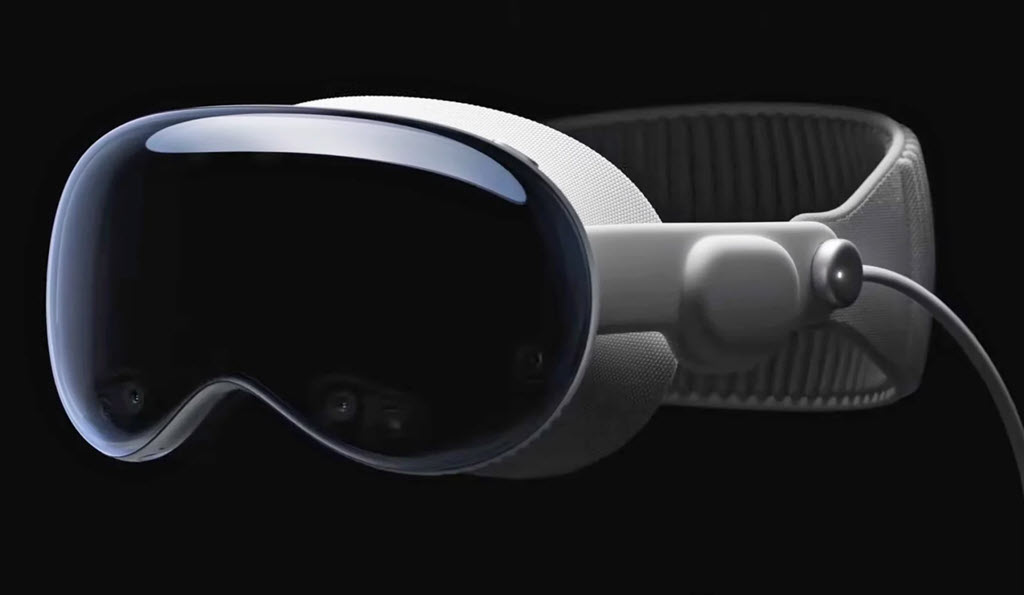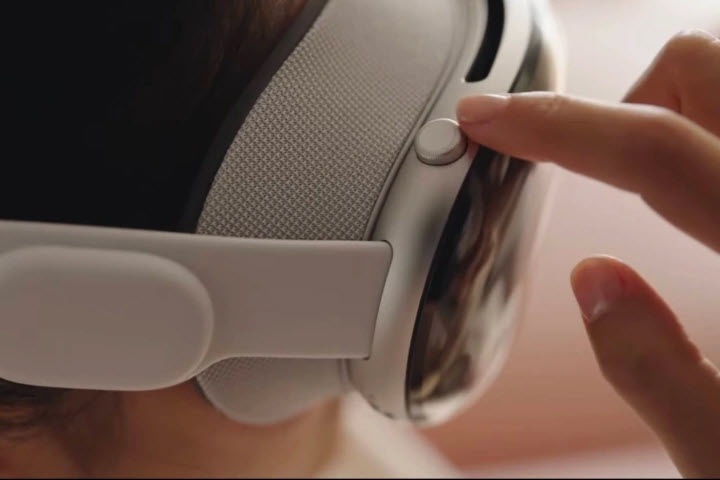
On Monday Apple introduced its long awaited new AR/VR headset, the “Apple Vision Pro,” along with a new operating system designed to work in the 3D environment seen through the device.
The Vision Pro is primarily a virtual reality device but it has some clever features to connect you to the outside world while you’re wearing it. Another way to imagine it: it’s an iPad or MacBook Air but everything is displayed in the air around you instead of on a screen. “Spatial computing” – get it?
It is Apple’s first push into a new form factor and OS since Apple Watch nine years ago.
There is a lot to say about the Vision Pro. I’m not going to rehash basic info about the tech specs and Apple’s presentation. Engadget has a six-minute distillation of Apple’s announcement at its developer conference on Monday. Or you can watch Apple’s nine-minute promotional video. If you’d rather read words, here’s a summary of the hardware and features.
Apple’s entry into the field of AR/VR carries huge weight. It provides validation for much of the work done by Meta, Microsoft, and others who have been stung by the backlash this year to metaverse hype. Eighteen months ago I described the road that would lead AR to become important and deeply embedded in our lives. Apple’s device is a necessary and crucial step on that road. This was my forecast in January 2022:
The first Apple glasses will be cool but they will NOT change the world, not right away. They will be expensive and limited by hardware that is elegant but probably not ready to wear out in the real world yet. There will be relatively few apps. It’s possible that AR’s technical difficulty will mean Apple’s first glasses will be VR only – but with the promise of AR to come.
Mass market consumer AR glasses are years away, with many technical problems to overcome first.
But Apple’s open embrace of augmented reality will bring awareness to the world. That’s what happens when Apple enters a market. It’s just fine if it takes a few years to refine a new Apple product and turn it into a mass market item.
Nailed it!
The Vision Pro is technically impressive. Apple made fascinating choices for its design and capabilities. I’m going to point out what’s missing from the Vision Pro but this is not intended to be critical. I have nothing to criticize. Some of Apple’s choices will be wrong or will evolve over time. But to be clear: the Vision Pro is an extraordinary technical achievement. Everything about it shows off Apple’s polished design aesthetic and high degree of integration and functionality.
Sometimes, though, spotting what is missing provides some insights that go beyond what is displayed.
Here are some of the things that were missing from the Apple Vision Pro announcement.
Vision Pro headsets are missing. Apple was under pressure to announce the Vision Pro, driven by the endless speculation in the tech world and by a desire to get developers thinking about AR, and probably also driven by Tim Cook’s enthusiasm. But the first headsets will not be shipped until sometime in 2024, later than hoped.
Customers will be missing. The first generation is not for consumers. It’s priced at an eyewatering $3,499. The only people who will buy it are developers seeking to be on the leading edge of a new platform, plus Apple die-hards and the small group of people who can spend that amount on a new tech gadget. Put the price out of your head! It literally doesn’t matter! Criticizing the price is lazy and misses the point. This is a test, generation zero, designed to find out what the first few users and developers think a spatial computer should be used for. Apple went through this process with the Apple Watch, introduced as a fashion accessory and morphing into a fitness device.
This is the opening play in a long game. Our world has trouble thinking past the short term. The headset is called “Vision Pro” so there can be a “Vision” or “VisionSE” down the road, priced for consumers, with a much more tuned set of features.
Virtual reality was missing from the announcement. The Vision Pro is first and foremost a virtual reality helmet with a better display than anything on the market and exceptional “passthrough” cameras to show the real world outside the headset. There will be countless comparisons to Meta’s Quest Pro and upcoming Quest 3 VR headsets, which are strictly for virtual reality cut off from the outside world. (You’ll be able to get seven Quest 3 headsets for the cost of the Vision Pro. Just saying.)

The function of the crown on the Vision Pro is to dial the environment from full passthrough of the real world to full immersion in a virtual world. But Apple never used the words “virtual reality.” The Vision Pro is a “spatial computer.” Okay, sure.

Augmented reality was missing, too. Apple clearly intends the Vision Pro to lead to an augmented reality world, with visual cues attached to physical objects. But this first glimpse of the Vision Pro almost exclusively showed flat screens hanging in space with no regard for other objects in the room. True AR appeared once and only once. Disney showed off a concept video with Mickey Mouse leaving a wall poster and jumping onto the floor, then jumping onto a chair in the room. That’s AR! And – that was it.
Apple is ignoring AI for now. Google and Microsoft employees are required to use “AI” or “GPT” in every single sentence they utter, including cocktail orders and requests to use the bathroom. Apple acts as if AI has not happened in 2023. No mention at its developer conference whatsoever.
In the next article I’ll give you a list of specific features that were missing from the cool videos of people using the Vision Pro. Did you notice no one had anything in their hands? And nobody moved from their spot on the couch? And everyone was alone? Each of those and more had me saying, Hmmmmm, as I watched the presentation. More to come!
